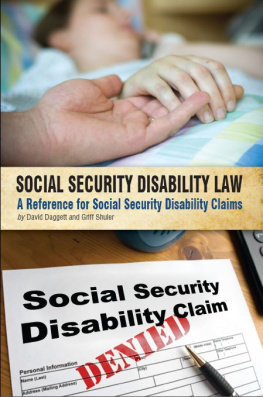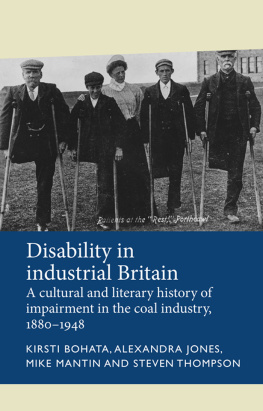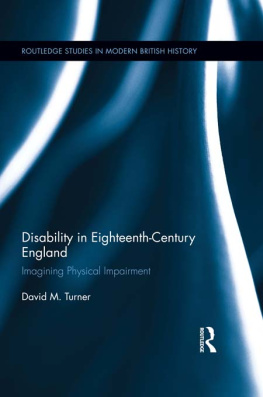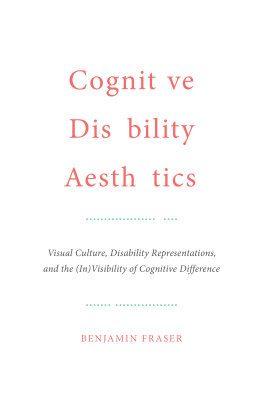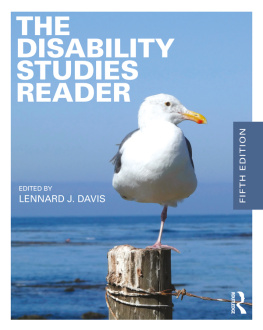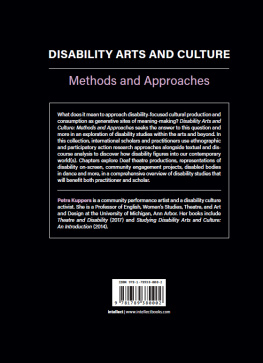
Disability Media Studies
Disability Media Studies
Edited by Elizabeth Ellcessor and Bill Kirkpatrick

NEW YORK UNIVERSITY PRESS
New York
New York University Press
New York
www.nyupress.org
2017 by New York University
All rights reserved
References to Internet websites (URLs) were accurate at the time of writing. Neither the author nor New York University Press is responsible for URLs that may have expired or changed since the manuscript was prepared.
ISBN : 978-1-4798-6782-0 (hardback)
ISBN : 978-1-4798-4938-3 (paperback)
For Library of Congress Cataloging-in-Publication data, please contact the Library of Congress.
New York University Press books are printed on acid-free paper, and their binding materials are chosen for strength and durability. We strive to use environmentally responsible suppliers and materials to the greatest extent possible in publishing our books.
Manufactured in the United States of America
10 9 8 7 6 5 4 3 2 1
Also available as an ebook
Contents
Elizabeth Ellcessor, Mack Hagood, and Bill Kirkpatrick
Elizabeth Ellcessor
Julie Passanante Elman
Alex S. Porco
Lori Kido Lopez
Ellen Samuels
D. Travers Scott and Meagan Bates
Krystal Cleary
Katie Ellis and Gerard Goggin
Tasha Oren
Shoshana Magnet and Amanda Watson
Robert McRuer
Toby Miller
Mack Hagood
Bill Kirkpatrick
Rachel Adams
Mara Mills and Jonathan Sterne
Film
Prosthetic Heroes: Curing Disabled Veterans in Iron Man 3 and Beyond
Ellen Samuels
Autism in Translation: Temple Grandin as the Autistic Subject
Tasha Oren
Any Day Now: Queerness, Disability, and the Trouble with Homonormativity
Robert McRuer
Sound Media
Throw Yo Voice Out: Disability as a Desirable Practice in Hip-Hop Vocal Performance
Alex S. Porco
Disability and Biomediation: Tinnitus as Phantom Disability
Mack Hagood
A Blessed Boon: Radio, Disability, Governmentality, and the Discourse of the Shut-In, 19201930
Bill Kirkpatrick
Television
After School Special Education: Sex, Tolerance, and Rehabilitative Television
Julie Passanante Elman
How to Stare at Your Television: The Ethics of Consuming Race and Disability on Freakshow
Lori Kido Lopez
Its Not Just Sexism: Feminization and (Ab)Normalization in the Commercialization of Anxiety Disorders
D. Travers Scott and Meagan Bates
The Price of the Popular Media Is Paid by the Effluent Citizen
Toby Miller
Transmedia and New Media
Kickstarting Community: Disability, Access, and Participation in My Gimpy Life
Elizabeth Ellcessor
One of Us?: Disability Drag and the Gaga Enfreakment of Fandom
Krystal Cleary
Disability, Global Popular Media, and Injustice in the Trial of Oscar Pistorius
Katie Ellis and Gerard Goggin
How to Get Through the Day with Pain and Sadness: Temporality and Disability in Graphic Novels
Shoshana Magnet and Amanda Watson
Toward a Disability Media Studies
Elizabeth Ellcessor, Mack Hagood, and Bill Kirkpatrick
In a crowded mall, a flash mob dances to the 1983 synth-pop hit Safety Dance, led by a slightly nerdy guy in a red sweater-vest (fig. I.1). He kicks, he gyrates, and for the grand finale he strides through the air, held up by other dancers as crowds of shoppers cheer. Then the music stops, he is dropped unceremoniously back into his wheelchair, and Arties dream of able-bodiedness ends in dejection at the reality of his disabled existence.
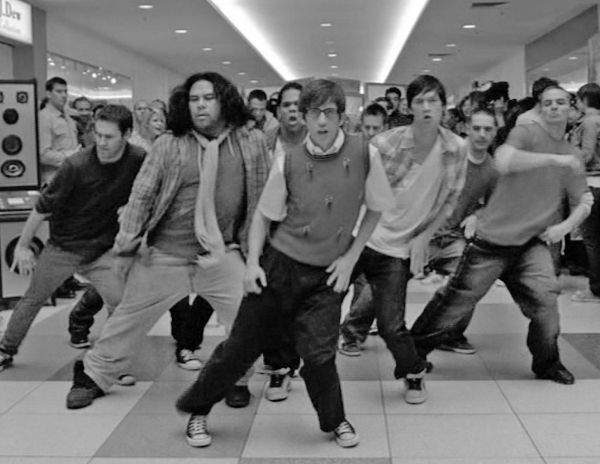
Figure I.1. A group of young men, with Artie front and center, doing a hip-hop-inspired dance in a shopping mall.
Clearly, many disagreed that the shows depictions were an unqualified success.
Not only is the representation of disability complicated, but the issue is becoming more urgent. As medical science achieves new breakthroughs in the repair of impairments, media representations of disability are proliferating as never before. In the early 21st century, television shows from House (Fox, 20042012) to Breaking Bad (AMC, 20082013) to Switched at Birth (ABC Family, 20112017) to Friday Night Lights (NBC, 20062011) prominently featured characters with disabilities. Major films like Avatar (James Cameron, 2009), The Kings Speech (Tom Hooper, 2010), and The Theory of Everything (James Marsh, 2014), among countless others, make disability central. Indeed, the full gamut of popular culturefrom athletes racing on carbon-fiber legs to viral videos of Deaf persons switching on their new cochlear implantsis awash in representations of disability. Beyond representation, disability is at the center of important technological innovations and political debates regarding a range of media technologies, such as the Digital Rights Management on e-books that ostensibly protects copyrights but has the side effect of preventing blind people from activating needed speech-to-text features.
Given all this, the question for researchers and students becomes: how do we make sense of the relationships between disability and media? We need perspectives and methodological tools to analyze how disability shapes media texts, technologies, and industriesand how our media, in turn, shape what it means to be disabled or able-bodied in contemporary society. We require ways of understanding disability and media in terms of political and economic forces; epistemology (how we come to know the world) and phenomenology (how we experience it); the stories we tell about it and the goals and constraints of the media industries that circulate those stories; material technologies and official policies; and audiences understandings of themselves and the world. We need theories and strategies that help us grasp the interplay of disability and popular culture, account for the slippery constructedness of disability and able-bodiedness, incorporate the knowledges and lived experiences of people marked as disabled, and analyze struggles over meaning, inclusion, and power.
Two main academic disciplines currently offer many of the theories and methods we need: disability studies and critical-cultural media studies. The rich history of disability studies provides a wealth of insights into disability as narrative trope, cultural identity, lived experience, socioeconomic status, and political category. Media studies is a humanities-centered, mostly qualitative field that explores how the media work as cultural, political, and economic institutions, as sites of meaning-making and ideological contestation, and as resources for social and individual identity formation and expression.
Importantly, however, neither disability studies nor media studies, on its own, has adequately grappled with the complexities of disability and media together. Scholars in each field are generating useful insights and approaches, but they are far from integrating the insights or building on the approaches of the other. In fact, often they are not even talking to each other: each has its own conferences, journals, Facebook groups, etc., and still rare is the crossover scholar who feels equally at home in both fields. Our claim is that these fields need to learn from each otherhave an interdisciplinary conversation, share insights and perspectives, and adapt the most useful theories and methodologies from each otherin order to advance our understanding of media and disability. This book stages one such conversation and begins to demonstrate the power of
Next page

